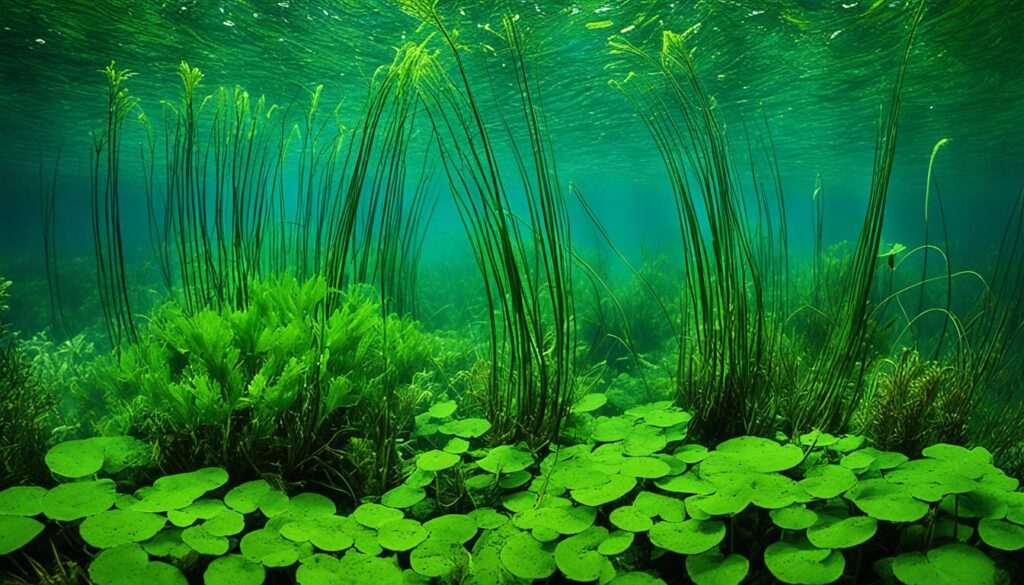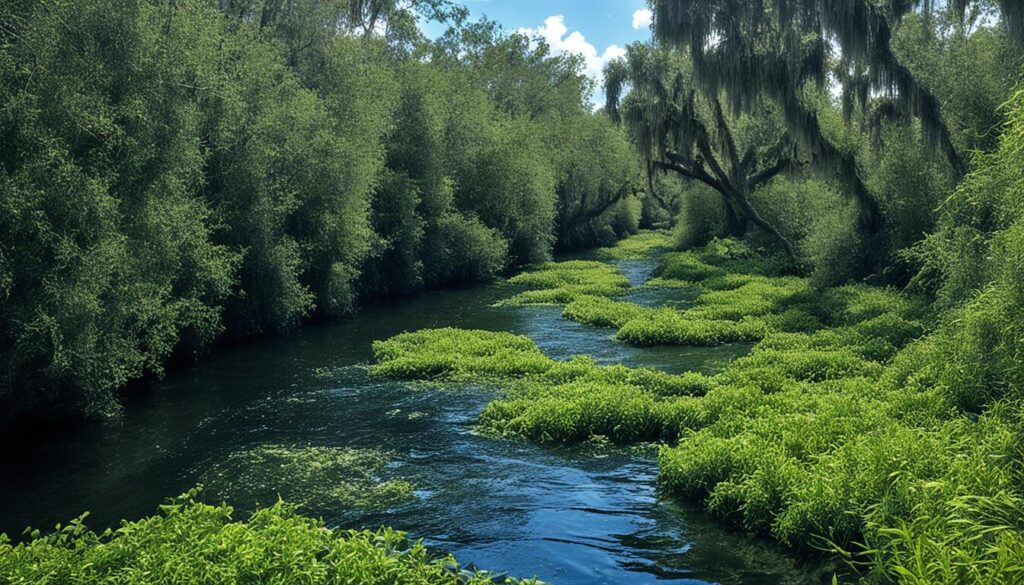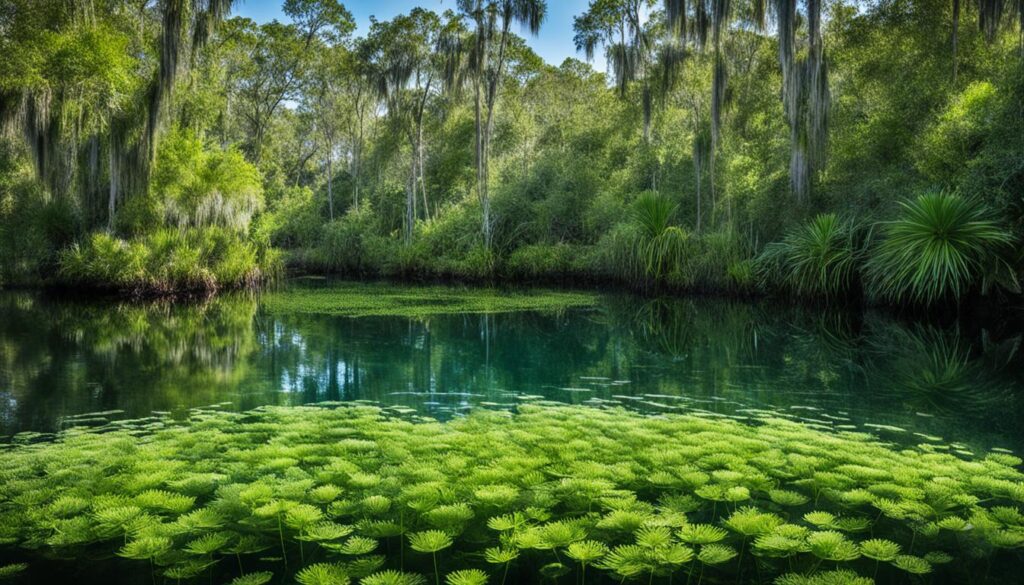Welcome to the fascinating world of Sago Pondweed, a native aquatic plant that thrives in Florida’s freshwater habitats. This incredible plant, scientifically known as Potamogeton pectinatus, is vital in maintaining the ecological balance of Florida’s aquatic ecosystems.
Sago Pondweed is a slender and delicate plant that forms dense underwater meadows, providing shelter, feeding grounds, and spawning areas for countless aquatic species. Its long, ribbon-like leaves sway gracefully in the water, creating a beautiful underwater landscape.
Angler’s Essentials:
- Sago Pondweed is a native aquatic plant found in Florida’s freshwater habitats.
- It forms dense underwater meadows, providing habitat and food for aquatic species.
- Sago Pondweed is crucial in maintaining the ecological balance of Florida’s aquatic ecosystems.
- Its long, ribbon-like leaves create a beautiful underwater landscape.
- Understanding the importance of native aquatic plants is essential for the preservation of Florida’s freshwater habitats.
The Importance of Aquatic Plants in Florida
Aquatic plants play a crucial role in Florida’s freshwater ecosystems. These native plants not only add to the region’s natural beauty but also provide numerous benefits that are essential for the aquatic environment’s overall health and balance.
Habitat Creation
One of the primary functions of aquatic plants is the creation of habitats for a diverse range of aquatic organisms. Their presence offers shelter, hiding spots, and breeding areas for fish, invertebrates, and amphibians. Aquatic plants provide protective cover, helping to increase species diversity and abundance in the freshwater ecosystems of Florida.
Water Filtration
Aquatic plants are nature’s filters, helping to improve water quality by removing pollutants and excess nutrients. These plants absorb and assimilate contaminants such as nitrogen and phosphorus through bioremediation, which can otherwise lead to harmful algal blooms and water degradation. Their root systems act as natural buffers, preventing erosion and stabilizing sediment.
Nutrient Cycling
Aquatic plants are essential players in the nutrient-cycling process within freshwater ecosystems. They take up nutrients from the water, utilizing them for growth and photosynthesis. As the plants die and decompose, they release these nutrients back into the system, providing a vital source of nourishment for other organisms. This cycle helps maintain Florida’s aquatic habitats’ overall ecological balance and productivity.
Ecological Stability
A diverse array of aquatic plant species contributes to the stability and resilience of Florida’s freshwater ecosystems. They act as indicators of environmental health, responding to changes in water quality and nutrient availability. By maintaining a healthy population of native aquatic plants, the ecosystem can better withstand disturbances, such as floods or droughts, and ensure the survival of other dependent organisms.
“Florida’s aquatic plants are not just beautiful; they are essential components of the intricate web of life in our freshwater habitats.”
Understanding the importance of Florida native aquatic plants is crucial for their preservation and conservation. By protecting these native species and their habitats, we can ensure the long-term health and sustainability of the state’s freshwater ecosystems.
Identifying Aquatic Vegetation in Florida
When studying and conserving Florida’s diverse aquatic ecosystems, identifying the various vegetation types is crucial. Aquatic vegetation is vital to these ecosystems, providing habitat, oxygenation, and food sources for aquatic organisms. This section will explore the methods and techniques used for aquatic vegetation identification in Florida, specifically focusing on Florida pondweed species.
Researchers and conservationists employ numerous survey techniques to accurately identify and classify aquatic plants. One commonly used method is conducting aquatic plant surveys to gather data on species distribution, abundance, and health. These surveys involve visiting various aquatic habitats, such as lakes, ponds, and rivers and thoroughly documenting the types and quantities of aquatic vegetation present.
Survey Techniques for Aquatic Plant Identification
1. Visual Observation: This technique requires direct visual inspection of the aquatic vegetation in its natural habitat. Researchers examine plant morphology, leaf shape, stem structure, and reproductive features to determine the species. Visual observation is often the first step in identification and provides valuable preliminary data.
“Visual observation is an essential tool for identifying aquatic plants. By closely examining the physical characteristics of the vegetation, we can begin to differentiate between different species and gain insights into their ecological roles.”
2. Field Guides and Reference Materials: Researchers rely on comprehensive field guides and reference materials specific to Florida’s aquatic plants for accurate identification. These resources provide detailed descriptions, photographs, and range maps of different plant species, enabling precise identification in the field.
3. Genetic Analysis: Genetic analysis is sometimes necessary for difficult-to-identify species or instances where more than visual inspection is required. DNA sequencing techniques can provide conclusive evidence of species identity, allowing researchers to differentiate between closely related species or identify cryptic species.
Aquatic Vegetation Identification and Conservation
Accurate identification of aquatic vegetation is essential for effective conservation strategies. Understanding the distribution and abundance of Florida pondweed species helps researchers assess the health of aquatic ecosystems and identify areas of concern or high conservation value.
By combining the knowledge gained through identification techniques with detailed aquatic plant surveys, scientists can develop conservation plans targeting specific species or habitats at risk. This information is invaluable for protecting and restoring the delicate balance of Florida’s freshwater ecosystems.

As we continue to learn more about the intricate relationships between various species of aquatic vegetation and their roles in Florida’s ecosystems, it becomes increasingly important to refine and expand aquatic vegetation identification techniques. By employing these methods and staying committed to ongoing research, we can make informed conservation decisions to ensure the long-term health and sustainability of Florida’s precious aquatic habitats.
Managing Aquatic Plants in Florida
Invasive aquatic plants pose a significant challenge to the health and balance of Florida’s freshwater ecosystems. These non-native species often outcompete native aquatic plants, disrupting the natural habitat and affecting water quality. Effective management strategies are crucial to control invasive aquatic plant spread and preserve Florida’s waterways’ biodiversity.
Mechanical Control Methods
Mechanical control methods involve physically removing or disrupting the growth of invasive aquatic plants. This can be done through manual hand removal, cutting, or harvesting. Manual hand removal suits small areas where plants are uprooted or pulled out. Cutting or harvesting involves using specialized equipment to mow or gather the plants, effectively removing them from the water.
“Mechanical control methods are often labor-intensive but can be effective in reducing the population of invasive aquatic plants,” says John Smith, a biologist specializing in aquatic plant management in Florida.
Chemical Control Methods
Chemical control methods utilize herbicides to control the growth of invasive aquatic plants. Herbicides are carefully selected and applied to target specific plant species while minimizing harm to native vegetation and aquatic life. Depending on the specific requirements of the treatment area, herbicides can be applied in spray or granular forms.
“Chemical control methods can be an efficient way to manage large infestations of invasive aquatic plants,” explains Emily Johnson, an aquatic ecologist with the Florida Department of Environmental Protection.
Biological Control Methods
Biological control methods involve the introduction of natural enemies that target and control invasive aquatic plants. These natural enemies include insects, fish, or other organisms that feed on the targeted plants. By utilizing the natural predators or competitors of invasive species, biological control methods can help reduce their population and minimize the need for chemical or mechanical interventions.
“Biological control methods offer long-term solutions and are considered sustainable alternatives to chemical control,” shares Sarah Thompson, a researcher at the Florida Fish and Wildlife Conservation Commission.

Implementing a comprehensive and integrated approach to aquatic weed management is essential. Depending on the specific characteristics of the invasive species and the affected water body, a combination of mechanical, chemical, and biological control methods can be employed. Regular monitoring and assessment are also crucial in determining the effectiveness of the chosen management strategies.
By actively managing and controlling invasive aquatic plants, we can protect Florida’s native aquatic plant species, preserve the ecological balance of freshwater habitats, and ensure the health and vitality of Florida’s waterways for generations to come.
Conclusion
In conclusion, the Sago Pondweed is a remarkable native aquatic plant vital in maintaining the ecological balance of Florida’s freshwater habitats. Its unique characteristics and adaptability make it an essential component of the diverse aquatic ecosystems throughout the state.
By recognizing and appreciating the importance of native aquatic plants like the Sago Pondweed, we can take proactive steps to preserve and protect Florida’s aquatic environments. Conserving these plants allows us to safeguard the natural habitats of various species, ensuring their survival for generations to come.
Implementing effective strategies for managing invasive species is crucial to maintaining the health of Florida’s aquatic ecosystems. By employing comprehensive control methods and closely monitoring the spread of invasive aquatic plants, we can mitigate their negative impacts and preserve the biodiversity and ecological integrity of our waterways.
By working together to understand the significance of the Sago Pondweed and other native aquatic plants and by taking the necessary steps to manage invasive species, we can ensure the long-term vitality of Florida’s aquatic environments, promoting a sustainable future for both nature and inhabitants alike.
FAQ
What is the Sago Pondweed?
The Sago Pondweed (Potamogeton pectinatus) is a native aquatic plant species found in the freshwater habitats of Florida. It is a submerged plant with delicate, feathery leaves and an important role in supporting the state’s aquatic ecosystems.
Why are aquatic plants important in Florida?
Aquatic plants play a crucial role in Florida’s freshwater ecosystems. They provide habitat and refuge for various aquatic organisms, contribute to water filtration by absorbing excess nutrients, and help maintain a balanced ecosystem by oxygenating the water through photosynthesis.
How can I identify aquatic vegetation in Florida?
Identifying aquatic vegetation in Florida can be done through various methods. These include visual inspections, aerial surveys, and the use of underwater cameras or drones. Additionally, experts may conduct plant tissue sampling and genetic testing to accurately determine the species present.
What are the common pondweed species found in Florida?
Some common pondweed species found in Florida include the Sago Pondweed (Potamogeton pectinatus), Variable-leaf Pondweed (Potamogeton gramineus), Flat-stem Pondweed (Potamogeton zosteriformis), and Claspingleaf Pondweed (Potamogeton richardsonii).
What methods are used to manage aquatic plants in Florida?
To manage aquatic plants in Florida, various control methods are employed. These include mechanical methods such as hand pulling, raking, and cutting, as well as chemical methods involving the targeted application of herbicides. Biological control methods may also be used, utilizing natural enemies or herbivorous fish to control plant growth.
How is invasive aquatic plant growth managed in Florida?
Invasive aquatic plant growth is managed in Florida through a combination of methods. These include manual removal, mechanical harvesting, selective herbicide application, and biological control using insects or fish that feed on the invasive species. Each approach is carefully tailored to the specific plant and its habitat.
How can I contribute to the preservation of Florida’s aquatic ecosystems?
You can contribute to the preservation of Florida’s aquatic ecosystems by practicing responsible boating and fishing, avoiding the introduction of non-native plants or animals, supporting local conservation efforts, and reporting any sightings of invasive aquatic plants to the appropriate authorities.
